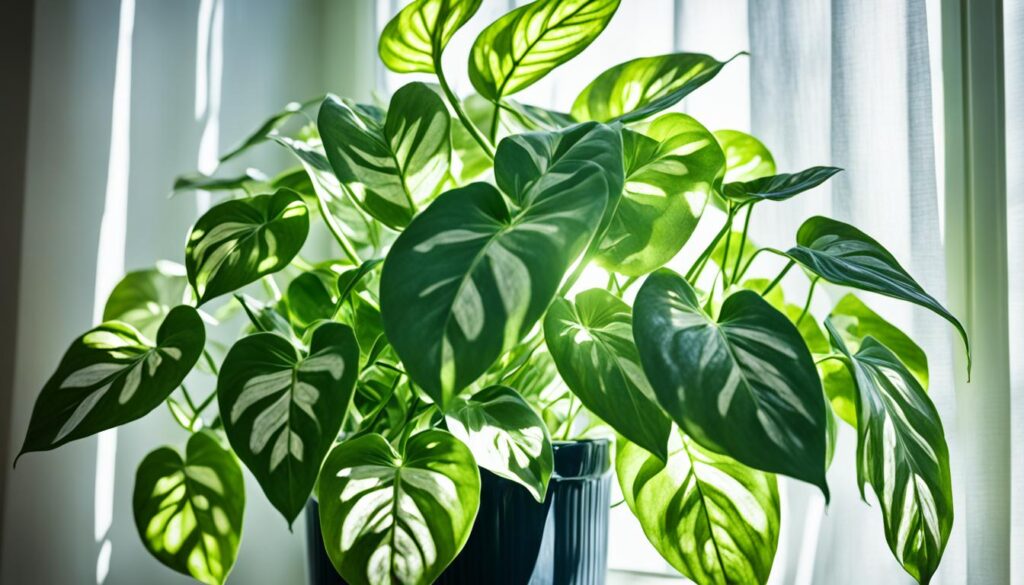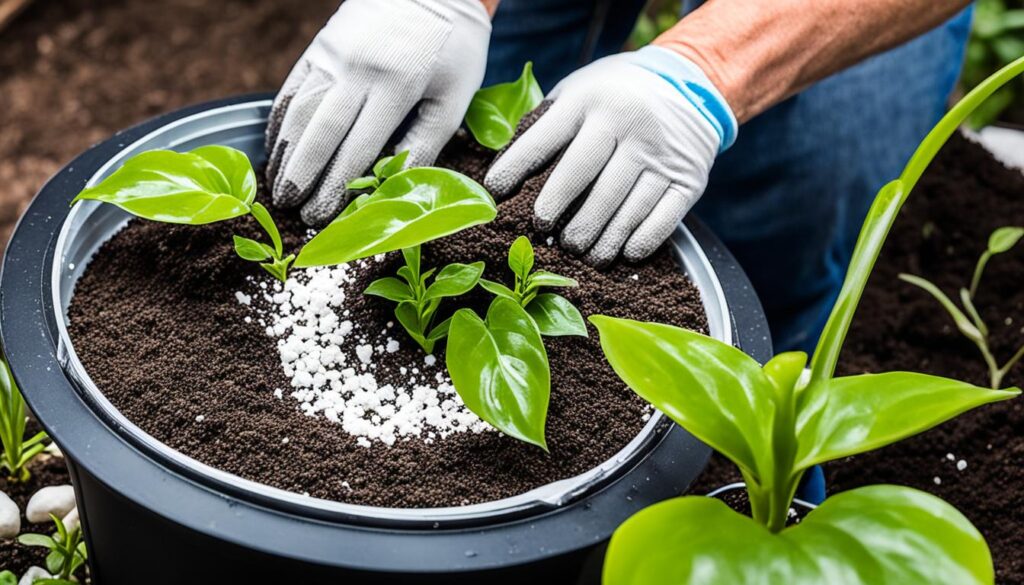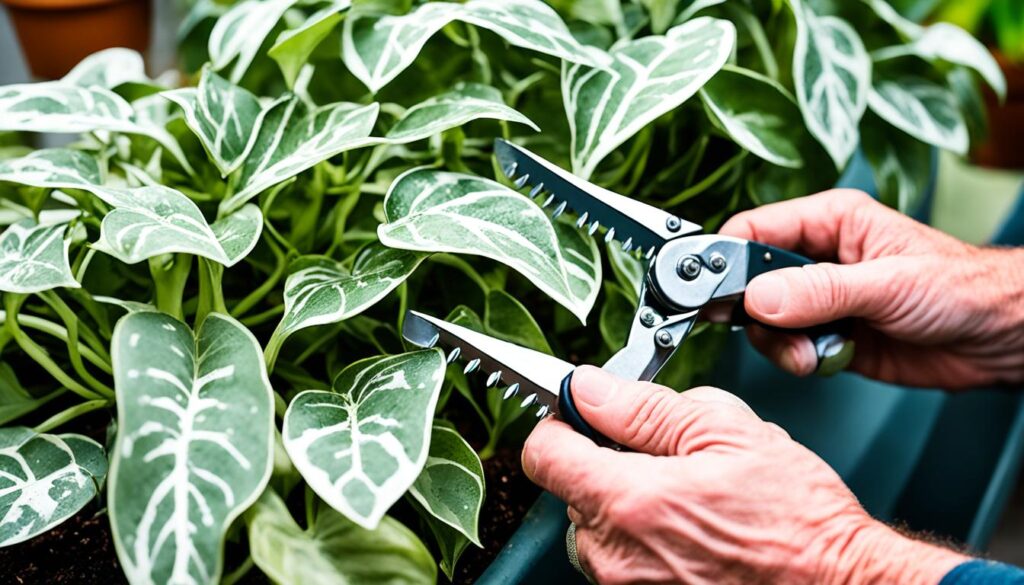The sun lit up the room, making the pothos plant’s silver leaves shine. Sarah felt happy seeing this houseplant in her living room. It reminded her of the beauty of nature inside her home. The silver pothos, also known as satin pothos or Scindapsus pictus ‘Exotica’, was now a favorite.
But, taking care of this plant needs some knowledge. You must know about the right lighting and watering. This guide will share important tips to keep your silver pothos healthy and bright.
Key Takeaways
- The silver pothos is a popular and easy-to-care-for houseplant with stunning silver-patterned leaves.
- Proper lighting, watering, soil, and other essential care are crucial for the silver pothos to thrive indoors.
- The silver pothos belongs to the Araceae plant family and is native to Southeast Asia.
- With the right growing conditions, the silver pothos can add a touch of lush greenery to any space.
- Regular pruning and propagation can help maintain the plant’s size and shape.
What is a Silver Pothos?
The silver pothos, also known as Scindapsus pictus ‘Exotica’, comes from Southeast Asia. It’s loved for its heart-shaped leaves with shiny gray patterns. These give it a shimmering look, earning it the name “silver pothos.”
Botanical Name and Origins
This plant is also called satin pothos or scindapsus pictus. It belongs to the Araceae family and is from the tropical parts of Southeast Asia. Countries like India, Bangladesh, Thailand, Java, and the Philippines are its home.
Distinctive Features
This vine can grow 4-10 feet long, perfect for indoor spaces. Its leaves are heart-shaped and have a unique silver-gray pattern. The Scindapsus pictus ‘Exotica’ variety is especially sought after for its beautiful silver leaves.
“The silver pothos is a must-have for any plant enthusiast looking to add a touch of elegance and drama to their indoor space.”
The silver pothos stands out with its cascading vines and shiny leaves. It’s a favorite among houseplant lovers for its beauty and low maintenance.
Lighting Requirements for Silver Pothos
The silver pothos is a versatile plant that does well in many lighting conditions. It grows best in medium to bright indirect light. But, it can also live in low indirect light, though its leaf patterns might not show as much.
To make sure your silver pothos gets the ideal lighting, don’t put it in direct sunlight. This can burn the leaves. If it’s near a sunny window, use a sheer curtain to soften the light and protect the plant.
“The silver pothos is a low-maintenance plant that can adapt to various lighting conditions, but for the best results, provide it with medium to bright indirect light.”
Knowing the silver pothos light requirements and giving it the right amount of light helps it thrive. With the correct lighting for silver pothos, you can enjoy its beauty for many years.

Watering Guidelines for Silver Pothos
Proper watering is key for your silver pothos plant’s health and life. This plant likes a steady, but not too wet, watering routine. Make sure the top inch or two of soil dries out before you water it again. Then, water well until water drains from the pot’s bottom.
Don’t let the soil dry out completely, or your plant may wilt and get damaged. But, too much water can cause root rot and turn the leaves yellow.
Signs of Overwatering
- Yellowing leaves
- Wet, soggy soil
- Foul odor from the soil
Signs of Underwatering
- Curling, wilting leaves
- Dry, crumbly soil
- Stunted growth
Watch the soil moisture and adjust your watering to keep your silver pothos healthy. The best watering schedule can change based on pot size, light, and season.
“Pothos plants are known for their resilience and ability to grow in water, making them a popular choice among plant enthusiasts.”
For a happy silver pothos, check the soil often and change your watering schedule as needed. With proper care, this easy-to-care-for plant can brighten any room.
Soil and Potting Mix for Silver Pothos
To make sure your silver pothos grows well, you need the best soil for silver pothos. This plant likes a potting mix that drains well and is full of nutrients. You can use a store-bought mix or make your own with peat moss, pine bark, and perlite or vermiculite.
For the potting mix for silver pothos, it’s important to keep the soil’s pH balanced. It should be between 6.0 and 7.0. This lets the plant take in nutrients and water well. Also, adding things like perlite or vermiculite helps prevent water from pooling and causing root rot.
For a well-draining soil for silver pothos, try this homemade mix:
- 2 parts peat moss or coir
- 1 part perlite
- 1 part orchid bark
- 1/2 part activated charcoal
This mix has the right mix of moisture, air, and nutrients for your silver pothos. Make sure your pot has good drainage holes to keep water from pooling around the roots.

“Providing the right soil conditions is crucial for the health and long-term success of your silver pothos plant.”
Temperature and Humidity Needs
The silver pothos is a versatile plant that can grow well in many temperatures and humidity levels. It prefers temperatures between 65°F and 75°F for the best growth. Make sure the temperature doesn’t go below 60°F to protect the plant.
The silver pothos likes moderate to high humidity. It can handle average humidity but benefits from extra moisture. Using a pebble tray or a humidifier can stop the leaves from turning brown.
Optimal Temperature Range
The best temperature for the silver pothos is between 65°F and 85°F. Temperatures below 60°F can harm the plant, causing slow growth or damage. Keeping the silver pothos in this temperature range is key for its health and looks.
“Providing the right temperature and humidity conditions is essential for keeping your silver pothos thriving and healthy.”
Fertilizing Your Silver Pothos
Proper fertilization is key for your silver pothos to stay vibrant and healthy. Feed your plant with a balanced, water-soluble houseplant fertilizer during the active growing season, which spans from spring to summer. Use half the recommended strength to prevent over-fertilizing, which can cause too much growth and nutrient imbalances.
Stick to a consistent fertilizer schedule to give your plant the right nutrients. This silver pothos fertilizer schedule should match the plant’s needs and your home’s growing conditions.
For the best fertilizer for silver pothos, choose a balanced, water-soluble formula with macro and micronutrients. Don’t use slow-release or granular fertilizers. They can be hard to control and might cause over-fertilization if not applied right.
“Proper fertilization is key to keeping your silver pothos thriving and vibrant throughout the growing season.”
Remember, a little goes a long way with houseplants. Stick to the recommended dosage and frequency to give your silver pothos the right nutrients without overdoing it.

How to care for a silver pothos?
Caring for a silver pothos means paying attention to its lighting, watering, and environment. Follow these key tips for growing silver pothos to help it thrive.
Start by giving your silver pothos medium to bright indirect light. Stay away from direct sunlight to prevent damage. It’s important to water it right – wait until the top inch or two of soil is dry before watering again. Make sure the soil isn’t too wet.
- Signs of overwatering include yellow or wilting leaves, while underwatering can lead to dry, crispy foliage.
Use a potting mix made for silver pothos plant care that drains well. Keep the humidity around 40-50% to keep your plant happy.
Feed your silver pothos a balanced, diluted liquid fertilizer every month when it’s growing. Trim any damaged or long leaves to keep the plant looking good and encourage new growth.
“Proper care and attention are essential for the caring for silver pothos to thrive and display its stunning, silvery-hued leaves.”
By following these easy yet effective tips for growing silver pothos, you can enjoy its beautiful, trailing foliage for many years.
Pruning and Shaping Silver Pothos
Keeping your silver pothos looking great means pruning and shaping it often. Cut off any dead or damaged leaves. If the vines get too long, trim them back. Prune in the spring when it’s growing well to encourage new growth.
To control its growth, train the silver pothos to climb a moss pole or trellis. This makes it look neat and upright. Shaping your plant helps manage its growth and keeps it looking neat.
Controlling Growth Habits
Pruning and trimming are key to managing your silver pothos’s growth. Use sharp shears to cut just above a leaf node at a 45-degree angle. This encourages new growth and prevents disease. But don’t prune too much, as it can harm the plant.
- Prune during the spring growing season for best results
- Focus on removing yellowed, damaged, or overgrown foliage
- Use clean, sharp pruning tools to make clean cuts
- Avoid over-pruning, which can stress the plant
Regular pruning and shaping keep your silver pothos lush and full. It also helps control its growth for a great look.

Propagating Silver Pothos
If you want to grow more silver pothos or share them with friends, propagation is the best choice. This plant is easy to grow from cuttings. You can make new plants with little work. Here’s how to propagate your silver pothos successfully.
Begin by taking 4-inch tip cuttings from your silver pothos in spring or early summer. Each cutting should have 1-2 leaf nodes and 1-2 inches of stem below the cut node. Then, remove the lower leaves, leaving only the top 1-2 leaves.
- Fill a clean pot or container with a well-draining potting mix, such as a blend of peat moss and perlite.
- Plant the cuttings in the potting mix, making sure the nodes are buried in the soil.
- Water the soil thoroughly, keeping it consistently moist but not waterlogged.
- Place the pot in an area with bright, indirect light, similar to the conditions your mother plant enjoys.
In about a month, you should see new growth. This means the cuttings have rooted well. Once the roots are strong, you can move the new plants into their own pots or add them to your collection.
“The key to successful silver pothos propagation is maintaining consistent moisture and bright, indirect light conditions throughout the rooting process.”
Patience and careful attention are key when propagating silver pothos. Check the soil moisture often and adjust your watering as needed. With a bit of care, you’ll soon have a thriving collection of silver pothos.
Common Pests and Diseases
The silver pothos is usually easy to care for, but it can face pests or diseases sometimes. Common problems include scale insects and spider mites. To fight these silver pothos pests, use a damp cloth to clean the leaves. Or, apply insecticidal soap or horticultural oil made for indoor plants. Be careful not to overwater, as this can cause root rot.
Pest Control Methods
Being proactive is crucial when dealing with silver pothos diseases and pests. Here are some ways to keep your silver pothos healthy:
- Regular inspection – Check the leaves and stems for pests or disease signs, like color changes, webs, or cottony stuff.
- Wiping leaves – Clean the leaves with a damp cloth to get rid of pests or dust.
- Insecticidal soap or oil – Use a mild, safe insecticidal soap or horticultural oil to kill pests on your silver pothos.
- Improving drainage – Make sure your silver pothos has well-draining soil to avoid root rot and moisture problems.
- Quarantine affected plants – If you see diseases or pests, isolate the plant to stop them from spreading to other plants.
By using these tips, you can help your silver pothos stay healthy and strong.

“Proactive care is the key to maintaining a healthy silver pothos. Regular monitoring and quick action can go a long way in preventing and managing any pest or disease issues.”
Repotting Silver Pothos
As your silver pothos grows, watch for when it needs a new pot. This plant should be moved every one to two years, or when roots start coming out of the pot’s holes. Spring is the best time to repot, when the plant is growing fast and can easily adapt.
When it’s time to repot, pick a pot that’s 1-2 inches wider than the old one. This lets the roots grow and the plant to keep doing well. Choose a potting mix made for aroid plants, like a mix of potting soil, perlite, and orchid bark.
- Gently remove the plant from its old pot, taking care not to damage the delicate roots.
- Inspect the root system and prune any damaged or overly dense roots.
- Place the plant in the new, slightly larger pot and fill in the sides with the fresh potting mix.
- Water the plant thoroughly to settle the soil and ensure good soil-to-root contact.
- Position the plant in a bright, indirect light location and monitor its water needs closely for the next few weeks as it adjusts to its new home.
With the right when to repot silver pothos, how to repot silver pothos, and silver pothos repotting schedule care, your silver pothos will keep thriving. It will show off its beautiful, silvery leaves for many years.
Toxicity Concerns
The silver pothos belongs to the Araceae family and has calcium oxalates. These make it mildly toxic to humans and pets if eaten. Ingesting these toxins can lead to skin, mouth, and throat irritation. This may cause discomfort in the mouth and stomach problems.
Keep the silver pothos away from kids and pets. Make sure no one chews on or eats the plant. If someone eats a lot of the plant, get medical help right away. For plant poisoning advice in the US, call (800) 222-1222.
- Calcium oxalate crystals in the silver pothos make it toxic.
- Symptoms of poisoning include mouth irritation, stomach issues, skin problems, and eye issues.
- Keep plants high up and teach kids about plant safety to prevent accidents.
- Use barriers and special rooms for plants to keep kids safe from toxic plants.
The silver pothos is a lovely houseplant but remember it’s toxic. By being careful and getting medical help if needed, you can enjoy its beauty safely. This way, you keep your family safe.

“Insoluble calcium oxalate crystals in silver pothos are the hidden dangers responsible for causing intense pain and swelling if chewed.”
If someone has severe pain, trouble breathing, or swelling that makes it hard to swallow or breathe, call 911 right away. Safe gardening and choosing non-toxic plants can make your home safer for everyone.
Conclusion
The silver pothos is a beautiful and easy-to-care-for houseplant. With the right care, it can flourish. Follow key tips for summary of silver pothos care like proper lighting, watering, soil, temperature, and humidity. Regular pruning and repotting also help keep it healthy and bright.
Keep in mind the plant’s key tips for growing silver pothos. It’s mildly toxic, so keep it away from kids and pets. With these easy yet effective tips, you can enjoy the silver pothos’s beautiful leaves in your home for many years.
Whether you’re an expert or a beginner, the silver pothos is a great choice. It brings natural beauty and purifies the air. By using this guide, you’ll learn how to care for your silver pothos plant easily.



Your point of view caught my eye and was very interesting. Thanks. I have a question for you.